The public has mixed views about the changing role of women in the workplace and the impact this has had on family life. Today women make up almost half of the U.S. labor force, and in 2012 nearly as many working-aged women (68%) as men (79%) were in the labor force.6 Most Americans applaud these trends, and very few would favor a return to more traditional gender roles. In a 2012 Pew Research survey, only 18% of all adults agreed that “women should return to their traditional roles in society.” Fully eight-in-ten adults (79%) rejected this idea.7
When it comes to mothers of young children, the public is more conflicted. Relatively few (21%) think the trend toward more mothers of young children working outside the home is a good thing for our society8, and only 16% say having a mother who works full time is the ideal situation for a young child.9
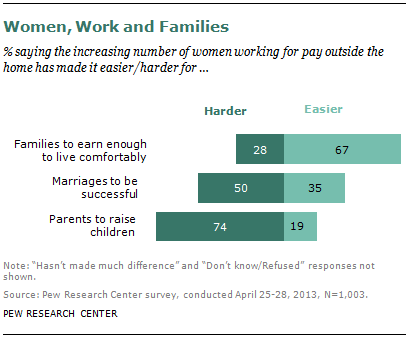
A new Pew Research Center survey, conducted April 25-28, 2013, finds that the public remains of two minds about the gains women have made in the workplace–most recognize the clear economic benefits to families, but at the same time many voice concerns about the toll having a working mother may take on children.
Respondents in the new poll were asked how the increasing number of women working for pay outside the home has affected different dimensions of family life. Fully two-thirds (67%) say this change has made it easier for families to earn enough money to live comfortably. About three-in-ten (28%) say this change has made it harder for families to earn enough, and 2% say it hasn’t made much difference in this regard.
While this trend may be beneficial for family finances, the public thinks having more women in the workplace has not had a positive effect on child rearing and even marriage. Roughly three-quarters of adults (74%) say the increasing number of women working for pay has made it harder for parents to raise children. Only 19% say this has made it easier to raise children, and 2% say it hasn’t made much difference.
Half of all adults say the trend toward more women working has made it harder for marriages to be successful. Only about one-third (35%) say this change has made it easier for marriages to be successful, and 5% say it hasn’t made much difference.
These attitudes have changed somewhat over the past decade and a half. In a survey conducted by the Washington Post, the Kaiser Family Foundation and Harvard University in 1997, most adults saw the economic benefits of having more women in the workplace: 60% said this trend made it easier for families to earn enough money to live comfortably. That share is even higher today (67%).
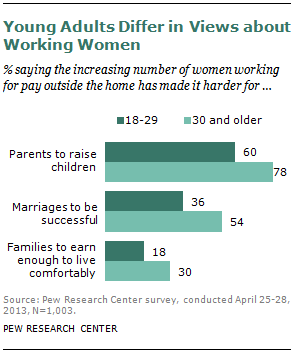
Compared with current attitudes, the public had a more negative assessment in 1997 of the effect this trend was having on children and marriage. Fully 82% said having more women working for pay outside the home made it harder for parents to raise children (compared with 74% today), and 67% said this trend made it harder for marriages to be successful (vs. 50% today).
There is no significant gender gap in views about how having more women in the workplace affects marriage and child rearing. However, men are more likely than women to see the economic benefits of this trend.
There are significant differences of opinion across age groups. Young adults (those ages 18-29) are less likely than older adults to see negative consequences from this trend and more likely to see positive effects.
For example, while 78% of those adults ages 30 and older say having more women in the workforce has made it harder for parents to raise children, only 60% of those ages 18-29 agree with this assessment. Similarly, while more than half (54%) of adults ages 30 and older say the rising share of women in the workplace has made it harder for marriages to be successful, only 36% of young adults agree. Not surprisingly, there are also large gaps by age in the incidence levels of marriage and parenting. Among the survey respondents, only about one-quarter (26%) of those ages 18-29 reported having a child under age 18. This compares with 66% of those ages 30-49. Roughly one-in-five (19%) of those under age 30 said they were married, compared with more than half (58%) of those ages 30 and older.
When it comes to earning enough money to live comfortably, young adults (79%) are more likely than those ages 30 and older (64%) to say having more women working outside the home has made this easier to accomplish.
The Rising Share of Single Mothers
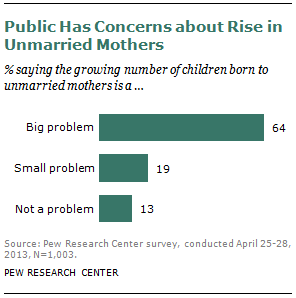
When it comes to the rising share of single mothers, the public takes a mostly negative view. About six-in-ten adults (64%) say the growing number of children born to unmarried mothers is a big problem. An additional 19% say this is a small problem, and 13% say this is not a problem at all.
Opinions on this issue have softened somewhat in recent years. In a 2007 Pew Research survey, 71% of adults said the rising share of single mothers was a big problem, and only 8% said it wasn’t a problem at all.10
In the current survey, whites are more likely than non-whites to see this trend as a problem. Some 67% of whites compared with 56% of non-whites say the growing number of children born to unmarried mothers is a big problem.11
Young adults have much different views on this issue than do middle-aged and older adults. Only 42% of those ages 18-29 view the rising share of unmarried mothers as a big problem. By contrast, 65% of those ages 30-49 say this is a big problem, as do 74% of those ages 50 and older. Among young adults, most say this trend is either a small problem (35%) or not a problem at all (19%).
What’s Best for Children?
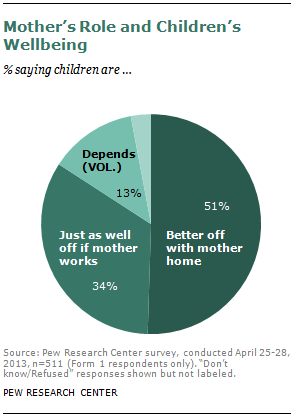
In 2012, roughly two-thirds (65%) of women with children younger than age 6 were either employed or looking for work. This share is up dramatically from 39% in 1975. While working outside the home is now more the norm than the exception for mothers of young children, the public remains conflicted about this trend. In the new Pew Research poll, 51% of the adults surveyed said children are better off if their mother is home and doesn’t hold a job, while only 34% said children are just as well off if their mother works. An additional 13% of respondents volunteered that it “depends” on the circumstances.12
A decade ago, the public felt even more strongly that the best thing for children was to have a mother who stayed home. In a 2003 CBS News/New York Times survey, 61% said children are better off if their mother doesn’t hold a job, while 29% said children were just as well off if their mother worked.
There is a gender gap on this question: 45% of women say children are better off if their mother is at home, and 38% say children are just as well off if their mother works. Among men, 57% say children are better off if their mother is at home, while 29% say they are just as well off if their mother works.
There is an age gap on this question as well. Again, young adults express a different set of views than their older counterparts. Nearly half (46%) of those under age 30 say children are just as well off if their mother works, while 37% say they are better off with a mother who stays home. Among those ages 30 and older, the balance of opinion is just the opposite: 55% say children are better off if their mother is home, and 31% say they are just as well off with a working mother.
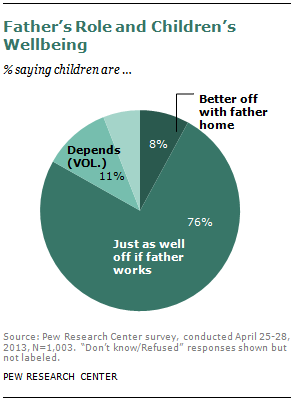
The public is not conflicted at all about whether fathers should work or stay home with their children. Fully 76% say children are just as well off if their father works, while only 8% say children are better off if their father is home and doesn’t hold a job. An additional 11% say it depends on the situation.
Views on whether fathers should work or stay at home do not differ by gender or age. Equal shares of men and women (76%) say children are just as well off if their father works. Similarly, 74% of young adults and 77% of those ages 30 and older agree that having a father who works outside the home is not harmful to children.13
What’s Best for Marriage?
These days, in most two-parent households (59%), both the mother and the father work outside the home.14 In a majority of those households, the father has a higher income than the mother, but for a growing share of these couples, the mother out-earns the father.
In the new Pew Research survey, respondents were asked whether they agreed or disagreed that it’s generally better for a marriage if the husband earns more money than his wife. About three-in-ten adults (28%) said they agree with this statement, while 63% said they disagree. When the same question was asked in 1997, a significantly higher share of adults (40%) agreed that it’s best for a marriage if a husband out-earns his wife, while 58% disagreed.15
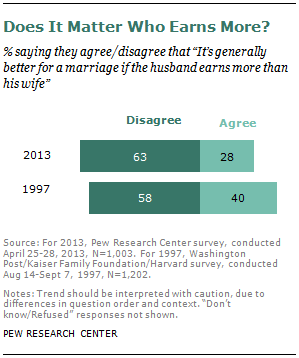
In the current poll, similar shares of men (62%) and women (63%) reject the notion that it’s best for a marriage if the husband out-earns his wife. And solid majorities of younger and middle-aged adults express the same view. Adults ages 65 and older are somewhat more conflicted about this. Among that age group, some 37% agree that it’s better for a marriage if the husband earns more money than his wife, and 51% disagree.
College graduates are among the least likely to agree that it’s better for a marriage if the husband out-earns his wife—only 18% support this view. Fully 75% of college graduates disagree with this notion. Among those with a high school diploma or less, roughly one-third (35%) agree that it’s better for a marriage if the husband has a higher income, while 54% disagree.




